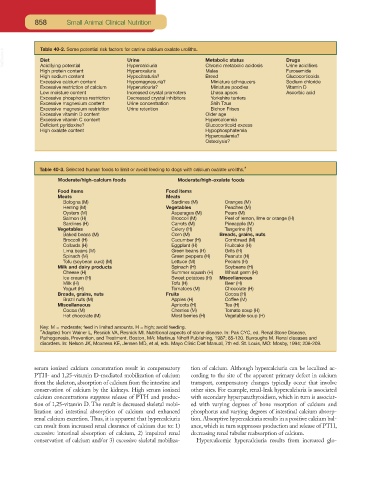Page 827 - Small Animal Clinical Nutrition 5th Edition
P. 827
858 Small Animal Clinical Nutrition
VetBooks.ir Table 40-2. Some potential risk factors for canine calcium oxalate uroliths. Metabolic status Drugs
Urine
Diet
Acidifying potential
Furosemide
High protein content Hypercalciuria Chronic metabolic acidosis Urine acidifiers
Males
Hyperoxaluria
High sodium content Hypocitraturia? Breed Glucocorticoids
Excessive calcium content Hypomagnesuria? Miniature schnauzers Sodium chloride
Excessive restriction of calcium Hyperuricuria? Miniature poodles Vitamin D
Low moisture content Increased crystal promoters Lhasa apsos Ascorbic acid
Excessive phosphorus restriction Decreased crystal inhibitors Yorkshire terriers
Excessive magnesium content Urine concentration Shih Tzus
Excessive magnesium restriction Urine retention Bichon Frises
Excessive vitamin D content Older age
Excessive vitamin C content Hypercalcemia
Deficient pyridoxine? Glucocorticoid excess
High oxalate content Hypophosphatemia
Hyperoxalemia?
Osteolysis?
Table 40-3. Selected human foods to limit or avoid feeding to dogs with calcium oxalate uroliths.*
Moderate/high-calcium foods Moderate/high-oxalate foods
Food items Food items
Meats Meats
Bologna (M) Sardines (M) Oranges (M)
Herring (M) Vegetables Peaches (M)
Oysters (M) Asparagus (M) Pears (M)
Salmon (H) Broccoli (M) Peel of lemon, lime or orange (H)
Sardines (H) Carrots (M) Pineapple (M)
Vegetables Celery (H) Tangerine (H)
Baked beans (M) Corn (M) Breads, grains, nuts
Broccoli (H) Cucumber (H) Cornbread (M)
Collards (H) Eggplant (H) Fruitcake (H)
Lima beans (M) Green beans (H) Grits (H)
Spinach (M) Green peppers (H) Peanuts (H)
Tofu (soybean curd) (M) Lettuce (M) Pecans (H)
Milk and dairy products Spinach (H) Soybeans (H)
Cheese (H) Summer squash (H) Wheat germ (H)
Ice cream (H) Sweet potatoes (H) Miscellaneous
Milk (H) Tofu (H) Beer (H)
Yogurt (H) Tomatoes (M) Chocolate (H)
Breads, grains, nuts Fruits Cocoa (H)
Brazil nuts (M) Apples (H) Coffee (M)
Miscellaneous Apricots (H) Tea (H)
Cocoa (M) Cherries (M) Tomato soup (H)
Hot chocolate (M) Most berries (H) Vegetable soup (H)
Key: M = moderate; feed in limited amounts. H = high; avoid feeding.
*Adapted from Wainer L, Resnick VA, Resnick MI. Nutritional aspects of stone disease. In: Pak CYC, ed. Renal Stone Disease,
Pathogenesis, Prevention, and Treatment. Boston, MA: Martinus Nihoff Publishing, 1987; 85-120. Burroughs M. Renal diseases and
disorders. In: Nelson JK, Moxness KE, Jensen MD, et al, eds. Mayo Clinic Diet Manual, 7th ed. St. Louis, MO: Mosby, 1994; 208-209.
serum ionized calcium concentration result in compensatory tion of calcium. Although hypercalciuria can be localized ac-
PTH- and 1,25-vitamin D-mediated mobilization of calcium cording to the site of the apparent primary defect in calcium
from the skeleton, absorption of calcium from the intestine and transport, compensatory changes typically occur that involve
conservation of calcium by the kidneys. High serum ionized other sites. For example, renal-leak hypercalciuria is associated
calcium concentrations suppress release of PTH and produc- with secondary hyperparathyroidism, which in turn is associat-
tion of 1,25-vitamin D. The result is decreased skeletal mobi- ed with varying degrees of bone resorption of calcium and
lization and intestinal absorption of calcium and enhanced phosphorus and varying degrees of intestinal calcium absorp-
renal calcium excretion. Thus, it is apparent that hypercalciuria tion. Absorptive hypercalciuria results in a positive calcium bal-
can result from increased renal clearance of calcium due to: 1) ance, which in turn suppresses production and release of PTH,
excessive intestinal absorption of calcium, 2) impaired renal decreasing renal tubular reabsorption of calcium.
conservation of calcium and/or 3) excessive skeletal mobiliza- Hypercalcemic hypercalciuria results from increased glo-

